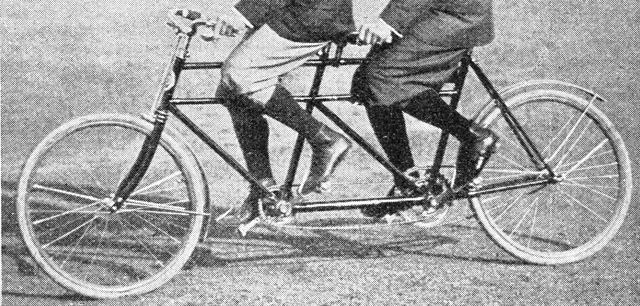05 September 2024
Some 84 million bicycles are to be found in garages and residential courtyards throughout Germany. Purely based on the maths, this would suggest that everyone in Germany, from the tiniest infant to the oldest retired person, has their own bike, which will in an increasing number of cases also have electric drive. In this brief history of the bicycle, we relate how the two-wheeler has evolved from its very early incarnation into the modern electric bike.
We’re in Mannheim, and it’s 12 June 1817. A gentleman can be seen bowling down the avenue which leads from the palace to the city. Between his legs is a weird-looking contraption. It has a wooden frame with two wheels, likewise made of wood, with metal reinforcements. A closer look reveals that the contraption is foot-powered. The man coasts along at incredible speed by simply pushing it along with his feet. Reaching speeds of between 13 and 15 kilometres per hour, he moves much quicker than a pedestrian or even a mail coach. The man is sitting on a kind of saddle and steering his contraption with a handlebar reminiscent of a stagecoach’s drawbar. His name is Karl von Drais.
When wheels first learn to run
He will later go on to say that the inspiration behind his “Laufmaschine” – a term which, as an inventive forestry official, he has coined himself and which translates as “running machine” – was ice skating. What is probably the world’s first bicycle already comes with a luggage rack behind the padded saddle and a brake on the rear wheel.
Drais’s invention is enthusiastically received as an alternative to the horse and catches on across Europe in the first instance before going global. But the “draisine” and the variants inspired by it are not destined to survive in the long term. The poorly maintained roads found in most places make riding it a back-breaking affair, not to mention the risk of accidents.
© WikimediaThe "Draisine" from 1818 can be marvelled at in the Dresden Transport Museum.
Early pedal power
In the 1860s, some 50 years later, some inventive types attach pedals with cranks to the axle of a draisine’s front wheel. Just who the inventors of the first pedal-powered running machine actually were has never been satisfactorily resolved. There is considerable evidence to suggest that this honour should go to coach builder Pierre Michaux and his son Ernest. And we do know for certain that Michaux unveiled two examples of his “velocipede” at the Paris World Exhibition in 1867, attracting international attention. This contraption with its cast-iron frame weighs over 30 kilogrammes, and the pedals can be adjusted to cater for different leg lengths. Braking force is provided by a brake block on the rear wheel. The velocipede’s front wheel is a little larger than the rear wheel to allow the contraption to reach greater speeds. This is because the front wheel is directly driven by the pedals. And the bigger the wheel, the longer the distance covered by a single revolution of the pedals.
Michaux teams up with his brother Olivier in 1868 to found Michaux & Co. 300 workers are employed by the company to build five of his “Michaulines” per day. But these “boneshakers”, as they mockingly become known by the public, leave a lot to be desired, in terms of both their technology and their comfort.
© Adobe StockHard cycling fun with the Michauline: Big at the front, small at the back - and the wheels are made of unyielding wood.
Running with rubber
The Hanlon brothers, a troupe of English artists, are the first to equip a Michauline with protective metal panels and a hand-operated front brake. In the same year, Eugène Meyer patents a Michauline in Paris with solid rubber tyres, spokes and an iron hub. This makes riding noticeably less hard on the body than is the case with metal-reinforced wooden wheels. This principle first goes into series production in 1871, in the form of James Starley’s “Ariel”. This technologically-savvy employee at a sewing machine factory in the English city of Coventry has identified a further advantage of wire spokes: They make it possible to increase the size of the front wheel without increasing its weight too much or reducing its strength. And, thanks to front-wheel drive, bigger front wheels mean higher speeds. Starley’s “Ariel” thus becomes the world’s first “penny farthing”. The front wheel has a diameter of 127 centimetres, and the much smaller rear wheel is little more than a stabiliser.
The higher you sit, the further you fall
In England, the penny farthing soon becomes a means of exercise and a status symbol for wealthy young men. And the ever-larger front wheels make the contraption impossible to overlook on the road, while also raising its rider up to the same height as aristocrats on horseback. But this elevated sitting position is also a big problem. Just climbing into the saddle takes both courage and agility. And when you finally get there, riding over any uneven surface can quickly send you tumbling back down to earth.
Forward-looking inventors therefore try to move the seat’s centre of gravity back and down to improve the bicycle’s safety. The “Xtraordinary”, built by sewing machine maker Singer, achieves this in 1878 with a backward sloping fork and a saddle repositioned to the rear. The “Kangaroo” brought out by Hillman, Herbert and Cooper in 1884 arrives at a similar solution. Its front wheel has been reduced to 92 centimetres in diameter, which is pretty modest for a penny farthing. And yet, thanks to the innovative chain drive on the front wheel and the associated transmission ratio, one revolution of the pedals allows it to cover the same distance as a penny farthing with a 142-centimetre wheel. The “Kangaroo” quickly gains popularity as a “dwarf safety bike” and spawns a lot of imitations. But it is still essentially a penny farthing with the same tendency to fall over and all the drawbacks of front-wheel drive: With every stroke of the pedal, the front wheel veers involuntarily to the left or the right unless the rider actively steers in the other direction to compensate.
Safety bicycle with rear-wheel drive
It was with this in mind that Thomas Shergold previously developed a bicycle in 1878 which was driven by a chain attached to the rear axle. This makes the outsized front wheel, with all the associated risk of falling, redundant. It is now the same size as the rear wheel. The lower centre of gravity over the rear wheel makes riding Shergold’s safety bicycle a much more stable experience. And rear-wheel drive means that the wheel does only what it is supposed to do, which is to go in a straight line.
In the years that follow, a lot of inventors experiment with rear-wheel drive. But the breakthrough is only achieved by the “Rover”, the brainchild of John Kemp Starley, James Starley’s nephew. With the arrangement of its operating components – the curved handlebar, height-adjustable saddle and rear-wheel drive – the “Rover III”, launched in 1888, is the prototype of the modern bicycle.
Pumped up diamonds
In the same year, Irish vet John Boyd Dunlop invents the pneumatic tyre with valve. Strictly speaking, he has reinvented the wheel: Englishman Robert William Thomson was awarded the patent for an air-filled tyre back in 1845. But this invention, which was never taken further, was soon forgotten.
Dunlop’s pneumatic tyres are much more adaptable to uneven road surfaces than the solid rubber tyres already in use and make cycling much more comfortable. With the introduction by Thomas Humber of the diamond frame in 1890, the basic architecture of the bicycle is complete. The diamond frame consists of two triangles: One is formed by the front tubes of the main frame, the other by the rear tubes. The advantage of the diamond frame is greater strength combined with the sparing use of material. This makes bikes lighter and cheaper, boosting their popularity and making them more accessible to the masses.
© Adobe StockFrom the 1880s, bicycles were also fitted with racing handlebars for the first time. Seen here: Ludovic Morin, three-time winner of the Grand Prix de Paris.
Coaster brake or derailleur
Fichtel & Sachs bring out the first freewheel hub with coaster brake in 1903. When cycling downhill, you no longer need to keep pedalling, and simply backpedalling brings the bike easily to a halt. This is followed two years later by the first hub gear system. Especially in Germany, hub gears and coaster brakes soon become the standard for town bikes for old and young alike.
The first derailleur system is developed by Paul de Vivie in 1906. de Vivie, the editor of a bicycling journal, experiments with chain rings of different sizes on the rear wheel and developers a changer to move the chain from one ring to the next. But it will take another 40 years for the first derailleur suitable for daily use to be released. The “Campagnolo Corsa” is launched in 1946, and its construction and operating principle will go on to become the blueprint for racing bike gears.
In terms of its basic elements, the bicycle is thus now technologically complete – but there is of course still plenty of development to come.






